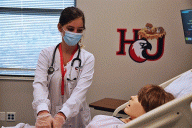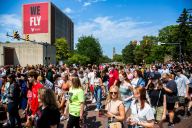You have /5 articles left.
Sign up for a free account or log in.

Students help stock and maintain mini food pantries on Virginia Commonwealth University’s campus.
VCU
Across Virginia Commonwealth University’s Richmond and Monroe Park campuses, there are a dozen small magazine distribution boxes perched inside facilities, filled with a variety of dry goods. These mini food pantries have a simple function: provide an easy, free and anonymous way to fight food insecurity.
Virginia Commonwealth University opened its campus food pantry in 2014, but officials recognized an increased need for food resources during the pandemic. A pre-pandemic survey had already found around 35 percent of students at VCU experienced some level of food insecurity, but only around 40 students per month were using the food pantry.
In 2021, John Jones, an assistant professor in the Center for Environmental Studies at VCU, received a grant from the university to pilot smaller dry goods food pantries.
With that funding, Jones and VCU students have implemented, stocked and tracked data from 12 mini pantries around the two campuses, providing cheap and private access to shelf-stable foods. This fall, a redesigned version of the mini pantries will roll out, allowing for further research and increased accessibility.
The background: Jones was inspired by a local mini food pantry outside a Montessori school in Richmond. A little free pantry builds off the idea of a little free library, from which community users can to take a book, leave a book or both from a weather-proof box outside.
A little free pantry is a small- to medium-size box that holds free shelf-stable items to provide increased access for food-insecure community members when they need it. Unlike traditional pantries, there are no hours of operation, no limit on items a person can take and no questions asked.
As someone who experienced food insecurity and poverty as a student, Jones was inspired to bring the idea to campus and create decentralized access to food for all who needed it as Little Ram Pantries.
Building up: During the 2021–22 academic year, Jones worked with students to research how best to set up a little food pantry.
They settled on yellow flier boxes, similar to those used by real estate agents or free community magazine distributors, because they were similar to the university colors and ADA accessible.
With the help of an engineering Ph.D. student, the boxes were configured to have a motion sensor to log every time the box was opened. The sensors have provided some data to establish a baseline of how many times it’s been opened and when.
The established VCU food pantry supplies the mini pantries with overflow dry goods and hygiene products. Students enrolled in Jones’s service-learning course are responsible for restocking the pantries every Wednesday.
The 12 boxes are scattered across campus, some in highly trafficked areas like the library or gymnasium, and others in quieter spots, like the environmental studies department offices. All pantries are located inside to keep the food at mostly stable temperatures.
Items range from granola bars and canned beans to tampons and soap, Jones says. Because the boxes are not monitored, Jones can’t report what items are taken or the average items taken per student, but ready-to-eat items seem to be the first to go, he says.
The impact: Students accessed the 12 boxes more than 2,400 times in 2021–22 and over 4,500 times during the 2022–23 academic year, as tracked by the in-box sensors.
%20final.png)
The most popular pantry locations were located at the library at Monroe Park and the Cary St. Gym and Engineering East building on the Richmond campus.
So far, the project has cost $20,000 over the two years, with most costs associated with student labor for restocking and the boxes themselves, Jones says.
Mutual aid: While Jones and his students are most responsible for the boxes, others on campus donate to the boxes, as well, he says. Some will email him first to ask permission, while others drop food off unexpectedly.
One concern when launching the boxes was whether students would disproportionately take from the mini pantries.
Data collected from the boxes show a standardized decrease in openings throughout the week, with the peak on Wednesday after a restock until the following Tuesday. “That seems to suggest that there’s still items left—people are not just taking their backpack, taking all the food, and then nobody ever opens it again because it’s empty,” Jones says.
Further evidence of conscious use was demonstrated through menstrual product inventory. One box had tampons available inside, and, rather than taking a whole box, supply dwindled by a few tampons each day. “Think of the statement that that makes on humanity, that not everybody is just taking whatever they want—they’re only really taking what they need,” Jones says.
The caveats: Managing a little free pantry is not without some risks or liability, so Jones and his team do their best to keep the experience safe and productive for all community members.
At every weekly restock, students complete a safety check of items, ensuring nothing has spoiled since the last restock and that no items were improperly placed (like items that need refrigeration, for example).
Getting food delivered to each of the boxes has also been a challenge, so for the upcoming academic year, VCU officials hope that the boxes can be sponsored by an academic division that is responsible for weekly upkeep, with Jones’s students providing monthly supplies to the sponsors.
The next level: Jones partnered with some mechanical engineering students to reimagine the mini pantries for better data collection and food distribution. In the second version, boxes have a sliding door (to aid in restocking) and a camera sensor that collects photos of the pantry interior (to help with supply and inventory).
Jones hopes to create a best practices resource guide for other institutions based on the research he and his team have collected in the first two years.
“It’s very much my intention to have all of this as open-access resources so that [whoever] hears about this and they’re like, ‘Oh, that’s so cool, how can we do this?’ Well, here’s the schematics, here’s the code, here’s the best management practice documents explaining how we did it,” he says.
Get more content like this directly to your inbox every weekday morning. Subscribe here.



